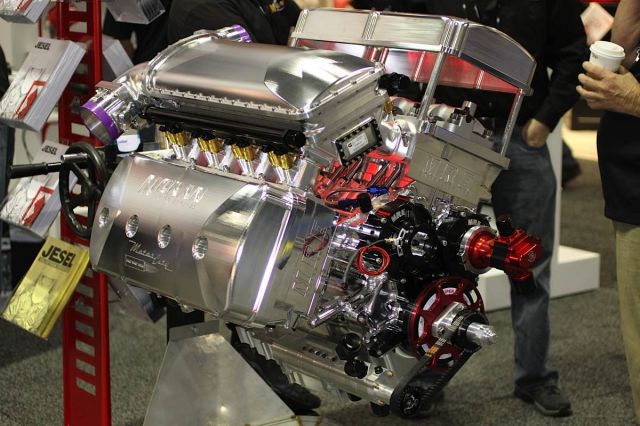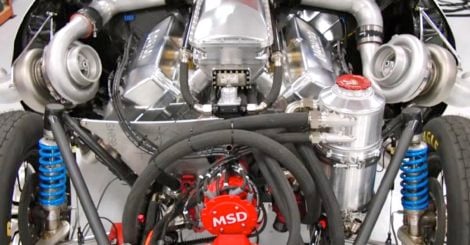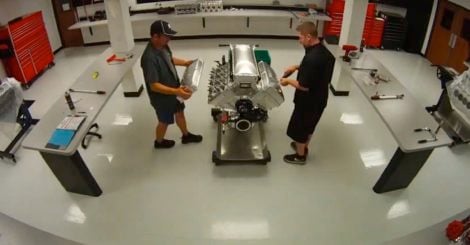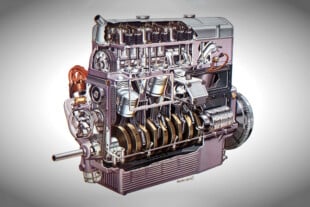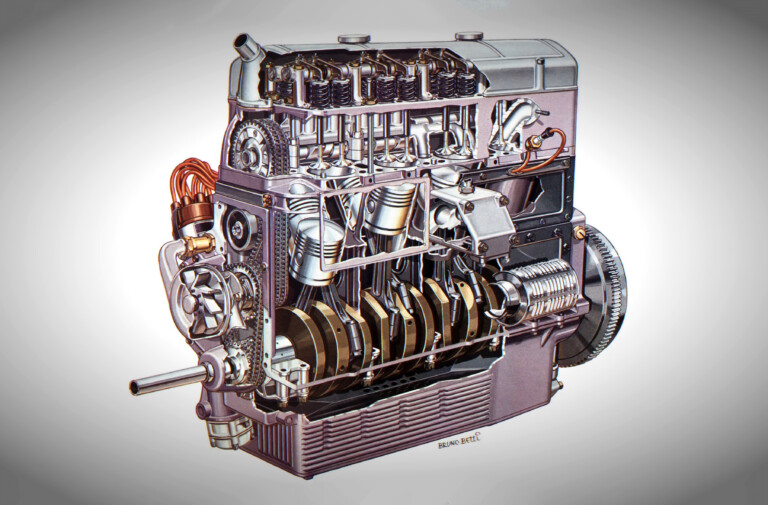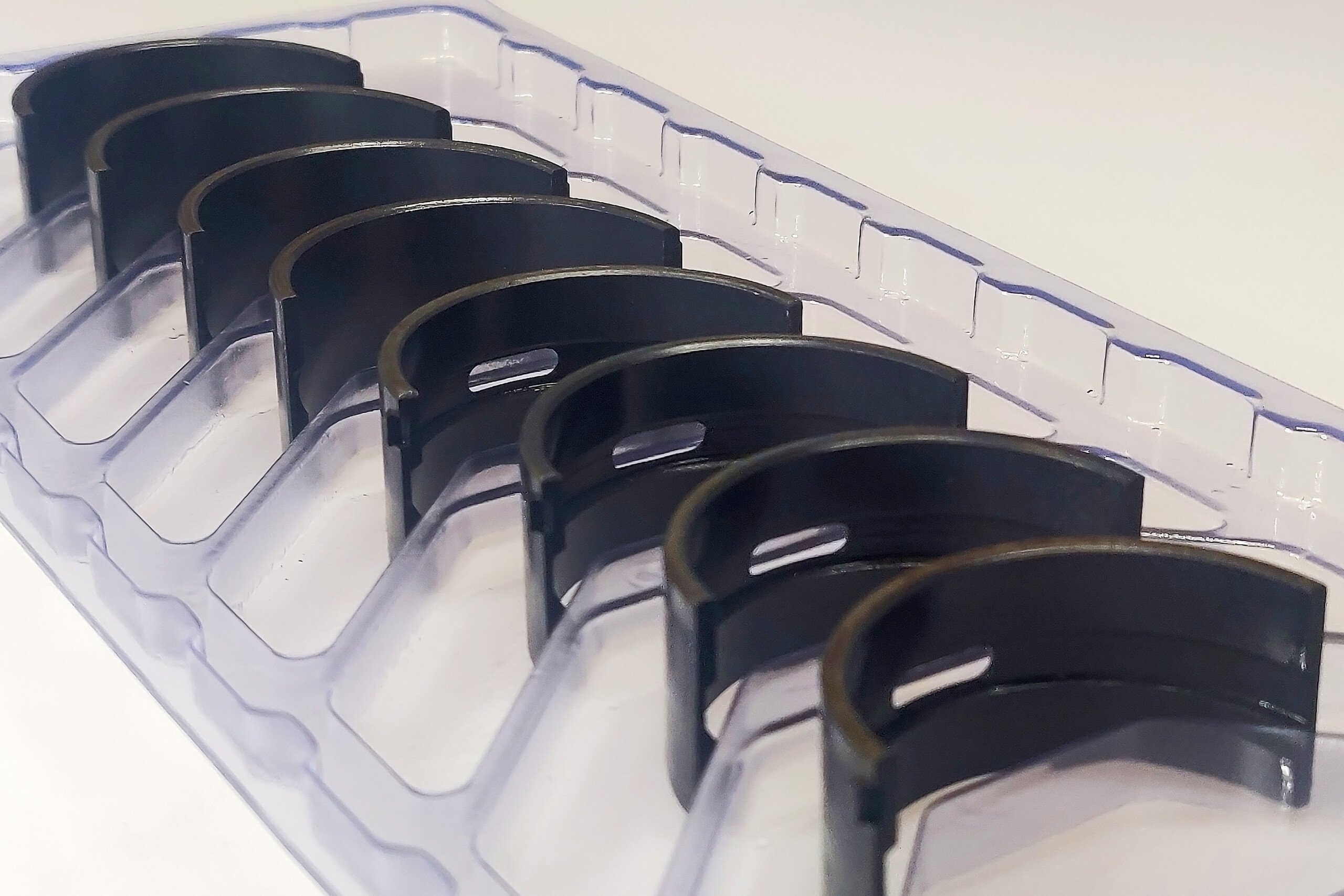Update: Moran Motorsports has just released a time-lapsed video (see top of page) showing the assembly of a new MRE all-billet engine that Engine Labs first featured following last year’s PRI show. The 670ci bullet is based on a 5.300-inch bore-space block and MRE hemi heads. It also features a unique valvetrain developed by Jesel and MRE injectors rated at 500 lb/hr. In a twin-turbo setup, the engine is reportedly capable of 4,000-plus horsepower. The video covers the 8-hour assembly, but MRE is quick to emphasize that it takes 4 weeks of preparation and test fitting before final assembly can be scheduled. The video is backed by the penetrating soundtrack of Imagine Dragons’ “Radioactive.” Enjoy!
If 4,000 horsepower is the norm for today’s high-end doorslammers, Mike Moran’s new all-billet engine just raised the bar another 10 percent.
“At 55 pounds of boost, this thing will make 4,400 pretty easy,” says Moran of Moran Racing Engines (MRE). “And I’m being conservative.”
In the works for almost four years, the clean-sheet engine design is the result of numerous consultations with trusted vendors such as Jesel Valvetrain, Dailey Engineering and Liberty’s Gears.
“Everybody jumped on board to do something out of the norm,” says Moran, who had the first turbo car to break into the 5-second class. “I wanted to build something to go to the outlaw races, but I was sick of following whatever was out there. I wanted to build the best motor I could.”
Working with Kyle at KCS Prototypes, Moran developed the basic architecture in SolidWorks. The cornerstone requirements were 5.3-inch bore spacing, raised cam location and hemi-style head design.
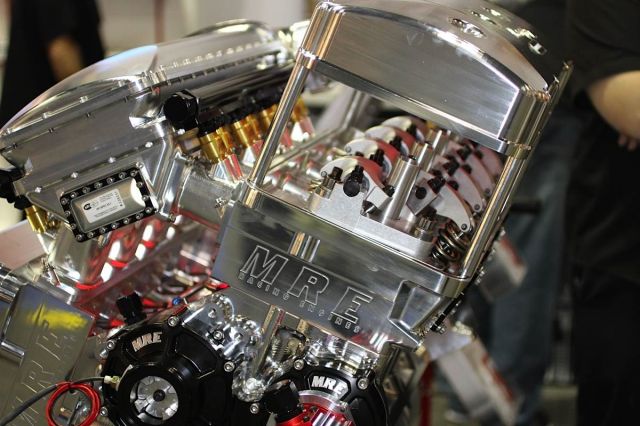 “Even before the first part was cut, we had two customers,” says Moran.
“Even before the first part was cut, we had two customers,” says Moran.
One year after the CNC machines received the initial programs, the first engine was built. Six months later came the second engine.
“We’re hoping to cut that down to three months,” adds Moran. “Even though every engine will be 100 percent custom.”
The massive alloy block and heads are solid billet, although Moran says they could be machined with water jackets. The block features a 10.5-inch deck height (taller deck heights could be offered in the future) and double-splayed 4-bolt mains, as Moran says he never favored the idea of skirted blocks or a cross-bolted main design. Dailey Engineering designed the integrated dry-sump oil pan/pump to match the bottom-end dimensions.
This particular engine photographed by EngineLabs at the PRI show displaces 637ci, but future engines can be built to order.
The 5.3-inch bore spacing allows a 5-inch cylinder bore while maintaining block rigidity. The cam centerline is raised “nearly three inches over stock” and, the cam tunnel features a unique 6-bearing layout to support 82mm cams, compared to nine bearings in other billet blocks or five in the traditional stock configuration.
“It’s not a 9-bearing but we were going to go that route,” explains Moran. “There are two things to keep in mind. Nine-bearing came out because cams were 65mm at the time and flexing. We’re at 82mm. Second, the downside to nine bearings is sacrificing lifter placement. Bearings get in the way and you can’t alway get the perfect pushrod.”
The right geometry
Valvetrain geometry is crucial to Moran’s engine, and he worked closely with Dan Jesel to achieve the desired angles and spacing.
“I had Danny draw up the perfect pushrod layout,” says Moran. “We stepped up one cam bearing and a whole lot in cam diameter to keep the pushrod locations.”
Jesel also designed a bolt-in lifter bushing so repairs could be made at the track, and Liberty Gears helped fabricate a 4-gear drive for the cam.
“Once we established the cam centerline, there was nothing out there. Danny could have made a belt drive, but we decided that with as much cylinder pressure that the engine will have, we’d go with a gear drive,” says Moran, noting there the drive utilizes crank, cam, idler gears along with an auxiliary “to drive anything I may want.”
The cylinder head design is traditional hemi but the dimensions grew exponentially with the 5.3-inch bore spacing.
“Also rolled the valve angle shallower to accommodate the bigger bore and better flow,” says Moran.
Moran’s personal design time focused on the intake manifold. Again, KCS helped with initial drawings and flow analysis in SolidWorks, but then friends of Moran working in the military put the designs through more rigorous fluid-dynamics simulation programs.
“That helped me change a few things on the outside that helped the flow on the inside,” says Moran, adding that boost will come from a pair of 94mm turbos.
The 4,400 horsepower estimate is based on comparisons with the engine that Moran used to break into the 5-second club a few years ago. That engine was estimated at 4,000 horsepower following math calculations and dyno runs with boost levels that the dyno could withstand. Moran has a test procedure where he takes readings at six, 15 and 25 pounds of boost.
“At six pounds, this engine is 500 horse better than the wedge I ran,” says Moran. “We could go up to only 21 pounds, and it hit 2,880 horsepower. At 55 pounds, it’ll make 4,400.”
How long before 5,000 horsepower will be the norm?



